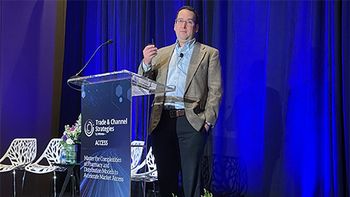
- Pharmaceutical Commerce - October 2022
- Volume 17
- Issue 5
Pharma's Future Supply Chains
New report explores what trends may lie ahead for pharma supply chains
In July 2022, EY published its new study,
In response to the challenges emerging from the COVID-19 pandemic and the other geo-political developments, policymakers worldwide have demonstrated increasing willingness to intervene in industry supply chains. Over the next decade, the report suggests, pharma will need to collaborate with policymakers to redesign the industry’s supply chain strategies.
Following the report’s publication, Pharma Commerce sat down with three of the principal authors—Olaf Zweig, EY-Parthenon partner (life sciences); Derron Stark, EY-Parthenon principal, strategy and transactions; and Famke Krumbmüller, EY EMEIA leader, Geostrategic Business Group—to discuss the study’s key findings and share predictions for pharma industry supply chains as we move into Q3 2022.
Pharma Commerce: This report comes after two tumultuous years of pandemic-related crises. What can we say the industry has learned from the past couple of years from a supply chain perspective?
Olaf Zweig: Obviously there have been a lot of developments around COVID, but the study is very forward-looking. There will be much more to come after COVID and everything around it. One thing we discovered, if you talk about the innovative pharma companies represented in the Pharmaceutical Manufacturing Forum (PMF) who we spoke to, is that they proved pretty resilient during the pandemic. Clearly, this came with a substantial effort, and there have been some shortages here and there, but if you look into the numbers in the US, Europe, and also Asia—and if you take out the totally COVID-related drugs—the service level didn’t slip away. We are looking into an industry that did a good job.
The second thing, which is not exclusively COVID-related but has COVID aspects to it, is that we’re seeing a deglobalization. Self-reliance, the focus on local supply, for example, is moving to the top of the supply chain agenda these days, if it isn’t already at the top. This has something to do with COVID, because the pandemic was a trigger point, but the trade zone related items underlying this shift had already started before COVID.
That leads me to the third learning. Rather than saying, “We need to localize everything,” there needs to be more of a hybrid model. Obviously, there will be localization of certain things, but as our report says, there are things that companies can do together that will make supply chains even more resilient, other than just saying everything needs to be localized.
And then, last but not least, we have seen during the crisis that there was good collaboration, not just between companies, but also between the industry and the governments and the regulatory bodies. Basically, everybody was aiming for the same target. We see this as something that needs to continue in a sustainable way.
Derron Stark: One of the surprises that the companies talked about was around the lack of visibility into their raw materials and component suppliers, and into their status of inventory and their ability to meet supply and demand schedules. And there was the vaccines scale-up that demanded sterile filters and disposable bio bags and thus impacted biologics manufacturing. This heightened the need for end-to end supply chain visibility and enabling technology. So, digital agendas for supply chain have been re-prioritized as a post-pandemic outcome, not only to get visibility into raw material and component supplies, but also to get better visibility into customers and customer demand. Big pharma, innovative pharma, looks at its distributor network as its customer, but the demand signal may sit two nodes down in a pharmacy, retail pharmacy, hospital pharmacy, or a healthcare provider. Getting that downstream visibility is important, as well as getting better demand signals and being able to respond. Ultimately, the digital agenda to enable supply chain visibility is one of the top priorities for our innovative clients.
Would you say globalization is off the table as we look ahead to the future of the supply chain?
Famke Krumbmüller: I would argue that globalization is definitely not over; it’s just going to take a different shape and form. I think regionalization is the right term. The image that I like to use is a pendulum swinging, and it swung to one extreme until everybody realized that these dependencies were not desirable and complicated for certain sectors. Now it’s just swinging back a little bit. Obviously, the question is, how far does it go into the other direction? But so far, what we are seeing is a clear tendency towards more regionalization. That means more regional trade, for example, and the statistics are starting to show more regional trade agreements and more importance put around local relationships. There is also more scrutiny, especially, of strategic supply chains, looking at what sourcing alternatives can be found within reasonable timeframes, etc. And what are the geopolitical relations with the country where these supply chains are potentially located? How could these political and geopolitical relations develop over the next couple of years?
All of these considerations have now become much more important as companies and regulators see the world moving into a new direction. Before, it wasn’t maybe as important to know about the political relationship between the country you are based in and the country in which you operate, or on which you’re dependent for supply chains. Now and going forward, that consideration will become front and center.
Olaf Zweig: The study takes the example of a small molecule drug, and looks all the way upstream to what is required in terms of raw materials and consumables: Basically, you see the entire globe being a source for certain things. From that angle, obviously, you can have some localization effort. We see that and also from a legacy point of view, we have some regional supply structures, as Famke said. However, there’s very little room to think that you can localize everything within the supply chain. While you can build a local manufacturing site covering the entire process from API manufacturing to secondary packaging, you still will need to source most raw materials and consumables globally. Thus, in theory, supply chain localization would need to cover suppliers, suppliers of suppliers and so forth. As we have seen with COVID, if one ingredient is missing (and it could even be some cleaning material), then you cannot manufacture your product.
However, if we talk about hybrid, there’s an example in the study of the ‘hub and spoke’ model. This is a cost-efficient model for localizing manufacturing (either end-to-end or in part) in a specific country. While the global hub is a full-scale manufacturing site, the spokes offer a small-scale operation, allowing limited supply chain operations to be executed locally. The approach offers sufficient locally based production capacity to meet the volume needed in a domestic market. This is the kind of model we expect to see much more in the future. It’s not globalization, neither is it localization, but for pharma companies it is a tailored approach.
Stark: Also, the strategy varies by type of the modality of product that we’re talking about, right? So, in small molecules, most of our clients view API manufacturing as a commodity service and are not likely to massively localize or have a disaggregated model. They’re more likely to purchase from a central organization. What the pandemic has highlighted is that it’s probably necessary to have a source in another major region as a warm back-up in case there is a disruption in supply.
Do you think the drive to more domestic manufacturing will be further encouraged by policy makers?
Krumbmüller: Definitely. We identified all the different measures that could be taken from the regulatory perspective and evaluated their political likelihood. We clearly saw that measures incentivizing localization are prominent. When you look at, for example, the European COVID recovery plans, there is a lot of investment already into more local R&D, more local manufacturing, etc. So, at this stage it is about incentives.
Stark: I won’t say that this broadly reaches across all pharma companies, but we have had several clients say that they’ve looked at their existing supply chains and unless there’s a driving force from a commercial perspective to create a new supply chain, from a resilience perspective, the investment is difficult to make, because there are a lot of other things impacting risk and quality and compliance. Where the incentives are driving more localization or regionalization is on new products, because that allows the ability to start from a clean slate and build a new supply chain.
Zweig: One of the key analyses we performed in the study was looking at what would it mean to have everything localized and what it would it mean to localize certain value chain steps. If you localize everything, you’re disaggregating global supply chains that have been built to be very efficient, to be very service orientated. This comes with an impact on speed to market; it means more manufacturing sites in more countries and that means more of a regulatory burden. It creates more jobs, but it comes with more complexity and additional costs. Our study presents some simple, digestible figures that explore the impact of localization and looks at potential alternatives to it.
If we could take COVID out of the equation and look at the continuity between 2019 and now in terms of supply chain evolution, what have remained the priorities from that time to this?
Zweig: If you ask the companies directly, they would say it’s about bringing innovative products to patients in the volume and in the time they need it. This paradigm and everything that’s related to it in day-to-day supply chain work is unchanged.
Stark: Also, there is the digital agenda around supply chain visibility. I would say that was on the agenda before the pandemic and it’s still on the agenda. Everybody’s driving toward automation, improving quality and compliance, reducing errors, and the need to remediate process deviations.
In view of the forward-looking nature of this report and its findings, what can we expect to see in the supply chain three or four years down the line?
Stark: For me, the hope is that we see a more active partnership and collaboration between public sectors, regulators, policy makers, and the industry to actually implement some of the things that will be most impactful. If companies operate in a vacuum or silo around their own four walls, they’ll only achieve what is best for their company, not necessarily for the industry.
Zweig: Two questions are, what is the industry able to do by being more collaborative, and what can governments, regulatory bodies, and the industry do together to accelerate certain things? One of the ideas in the report is that pharmaceutical companies that are compliant all the way through and have a very strong legacy of bringing a compliant product to the market, from a manufacturing and supply chain point of view could accelerate approval timelines to bring about certain changes.
Also, I think we’re seeing evolving priorities in the industry, for example, about how important resilience is becoming in an overall agenda setting, including the CEO agenda. Resilience will be a part of the investment decisions of the future, which will take the geopolitical context into consideration much more than before, looking at how different trade zones are affected by things like inequity and anticipating potential crises or uncertainties in certain regions.
Krumbmüller: We don’t know exactly what the world will look like in five years, but we know for sure it will look very different from five years ago. And so, governments, regulators, as well as companies will have to adapt to that. Those that anticipate the most and engage the most with others to try and find solutions will be the ones that will win in that new—or at least very different—market of the future.
Articles in this issue
about 3 years ago
Pharmaceutical Commerce - October 2022 Issue (PDF)about 3 years ago
Decisive Moves on the Digital Supply Chainabout 3 years ago
Betting the House on Orphan Drugsabout 3 years ago
Cold Chain Tech Continues to Evolveabout 3 years ago
Building a Robust Cold Chain for CGTsabout 3 years ago
Keys to CGT-Supply Chain Integrationabout 3 years ago
‘Old School,’ New Technologyabout 3 years ago
Building the Cold Chain of the Futureabout 3 years ago
Choosing the Right Monitoring Deviceabout 3 years ago
Global Logistics: A Cold Chain BlueprintNewsletter
Stay ahead in the life sciences industry with Pharmaceutical Commerce, the latest news, trends, and strategies in drug distribution, commercialization, and market access.




